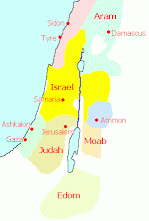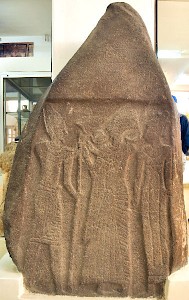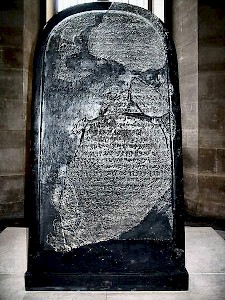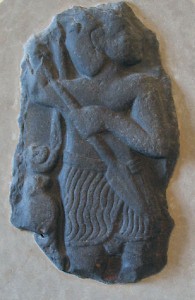Moab
Q326304Moab: Bronze and Iron Age kingdom, directly east of the Dead Sea, situated in modern Jordan.

The kingdom of Moab was situated between Ammon in the north, Edom in the south, the desert in the east, and the Dead Sea in the west. It is mentioned several times in the Bible, but the oldest reference to the land is in an Egyptian inscription from the age of Ramesses II (1279-1213). We also have Assyrian references to the existence of this small Bronze and Iron Age state, which, according to archaeologists, retained its (semi)tribal nature for a long time, even though there were several towns. This qualification is corroborated by the fact that the Bible mentions a ninth-century leader who was raising sheep.note
Early History
As a political unit, Moab existed in the thirteenth century, when pharaoh Ramesses II ordered a punitive campaign against the nomads. This agression did not prevent cultural influence: the slightly younger "Balu Stela", now in the Museum of Amman, proves that at least one Moabite artist took inspiration from Egypt.

The Bible refers to an early war between a chief of the Amorites, Sihon of Hesbon, and the Moabites,note and tells that Moses led the Hebrews through Moab, before he died on Mount Nebo.note Although the historicity of this story is not uncontested - the twelfth, eleventh, tenth, and ninth centuries are a notoriously dark period - it is certainly possible that nomads moved up and down along the Royal Road, through or around Moab. The story about Moses' wandering Hebrews cannot be confirmed, but is not inherently implausible.
The unstability of the situation is also shown in Judges, which tells how the Moabite leader Eglon allied himself to the Ammonites and Amalekites, and captured the City of Palm Trees (Jericho). In the end, the Jewish judge Ehud assassinated Eglon.note Other conflicts are mentioned in the age of king Saulnote and king David, who executed many Moabite POWs.note David's son Solomon (c.970-c.931) was married to a Moabite lady and venerated the Moabite god Kemoš.note
Independence

Moab may have been independent after the reign of king Solomon, but is later mentioned as subject to the kingdom of Israel. According to 2 Kings, the Moabites rose in revolt after the death of the Israelite king Ahab (851), but were mercilessly punished by his grandson Jehoram.note Nevertheless, the author of this account does not deny that the Israelites were unable to capture the royal residence. Possibly, Jehoram had to return to fight against Aram-Damascus or feared the Assyrian invasion of 841.
The Stela of Mesha, which was found in the ancient Moabite capital of Dibon, confirms that the Moabites fought against a descendant of Ahab, and mentions two forts built by Israel, which were eventually taken over by Moab. The inscription also mentions the Biblical tribe of Gad as related to the Moabites, and proves that the main god of the Moabite pantheon was Kemoš.
It also proves that the people spoke a language that closely resembled Hebrew, and it may be no coincidence that the Bible mentions that king David had a Moabite grandmother.note Yet, relations to the Jews were not always friendly. Jeremiah predicted doom for the Moabites,note Amos was angry at them,note and Numbers contains the story that in the days of Moses, a Moabite king named Balak hired the prophet Balaam to curse the Hebrews. Instead, he blessed them. The third blessing contained the following, very important line:
I see him, but not now; I behold him, but not near. A star shall come out of Jacob and a scepter will rise out of Israel. It shall crush the foreheads of Moab and break down all the sons of Sheth. Edom shall be dispossessed.note
This line has become pivotal to later Messianism, and ensured that the name of "Moab" remained in use for the enemies of Israel, no matter what their real ethnicity. It is interesting to note that a temple has been excavated at Deir 'Alla, where in the late ninth and early eighth century, oracles were given in the name of Balaam (more...).

By now, the Assyrians had already shown an interest in the land west of the Euphrates. It seems that during the reign of Tiglath-Pileser III (745-727), king Kemoš-Nadab of Moab submitted himself peacefully to Assyria, perhaps out of fear for Aram. Being a vassal state, Moab retained some of its independence; Ammon and Edom pursued the same policy, and so would Judah. Israel, on the other hand, was annexed. Tribute by the Moabite king Musuri is mentioned during the reigns of Sennacherib (705-681) and Esarhaddon (680-669); Assyrian sources also refer to small-scale wars against nomadic tribes. For example, king Kemoš-Haleth defated some Beduins.
Province of the Eastern Empire
As Assyrian vassal, Moab had retained some of its independence, but when the Assyrians had been superseded by the Babylonians as leaders of the Near East, Moab and Ammon were, in 582, reduced to the rank of province of the Babylonian Empire.note Judah had already been annexed in 587 - Jerusalem was sacked - and Edom seems to have been conquered in 553.note
The country's history was now identical to that of the Near Eastern empire: when the Persians took power in 539, they also became the new masters of the province of Moab. When the Macedonian conqueror Alexander the Great subdued the Persians after 334, he took over Moab. After this, Moab disappears from our sources. The country was taken over by the Nabataeans.note The reference to Moab in Danielnote is a deliberate archaism.